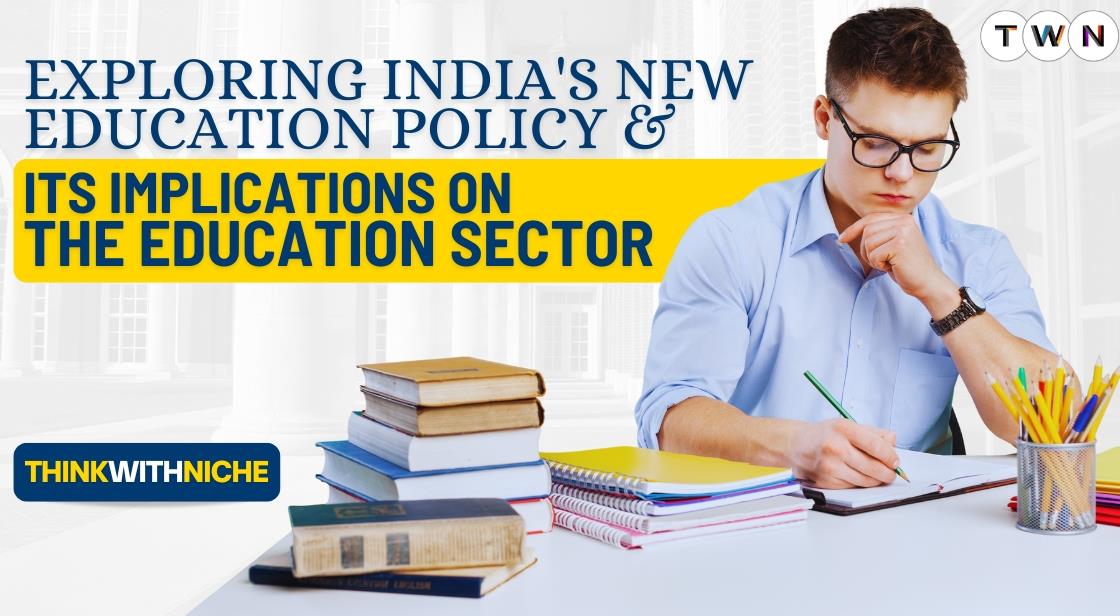Exploring India's New Education Policy and Its Implications on the Education Sector

Blog Post
India's New Education Policy (NEP) has sparked widespread interest and discussion since its announcement, promising transformative changes to the country's education landscape. As we delve into exploring its implications on the education sector, it is essential to understand the context and rationale behind this policy overhaul.
The NEP, approved by the Union Cabinet in July 2020, marks a significant milestone in India's educational journey, replacing the three-decade-old National Policy on Education, 1986. It aims to address the evolving needs of the 21st century and align India's education system with global standards while preserving its cultural heritage and diversity.
At its core, the NEP envisions a learner-centric, holistic, and inclusive education system that fosters critical thinking, creativity, and innovation. It emphasizes universal access to quality education from early childhood to higher education and seeks to bridge the gap between different stages of learning.
One of the key implications of the NEP is its focus on foundational literacy and numeracy, recognizing the importance of building strong foundational skills in students during the early years of schooling. It also emphasizes the integration of vocational education and skill development into the mainstream curriculum, aiming to equip students with practical skills for employability and entrepreneurship.
Furthermore, the NEP proposes structural reforms in school education, including the introduction of a new curricular framework, flexible learning pathways, and assessment reforms to reduce the emphasis on rote learning and promote holistic development.
As we embark on this journey of exploration, it becomes evident that the NEP has the potential to shape the future of education in India, empowering learners, educators, and stakeholders to adapt to the changing demands of the 21st century and contribute meaningfully to society and the economy.
New Education Policy 2020: Reshaping India's Educational Future
1. Introduction to India's New Education Policy (NEP)
The National Education Policy (NEP) of 2020 represents a significant paradigm shift in India's education landscape. This comprehensive framework, introduced by the Government of India, marks a departure from the National Policy on Education of 1986, with the aim of addressing the evolving needs and challenges of the 21st century.
NEP seeks to overhaul the entire education system, encompassing aspects ranging from early childhood education to higher education and vocational training. It emphasizes the importance of holistic development, promoting multidisciplinary learning, and integrating vocational skills into the curriculum from an early age.
NEP also prioritizes universal access to quality education, with a focus on inclusivity and equity. By addressing longstanding issues and embracing innovative approaches, NEP endeavors to create a dynamic and future-ready education system that prepares students to thrive in a rapidly changing world.
5+3+3+4 Structure of National Education Policy 2020
The National Education Policy 2020 (NEP 2020) in India outlines a new vision for the education system. One of its key features is the restructuring of the school curriculum into a 5+3+3+4 format. Here's what each segment represents:
1. Foundational Stage (5 Years)
- This stage covers early childhood education, typically for children aged 3 to 8 years.
- It consists of three years of preschool (Anganwadi or pre-primary school) followed by two years of primary school (Classes 1 and 2).
2. Preparatory Stage (3 Years)
- This stage bridges the gap between early childhood education and formal schooling.
- It comprises Classes 3 to 5, focusing on building foundational skills in numeracy, literacy, and other subjects.
3. Middle Stage (3 Years)
- At this stage, students delve deeper into various subjects while continuing to develop critical thinking and problem-solving skills.
- It includes Classes 6 to 8, where students explore a broad range of disciplines to foster holistic development.
4. Secondary Stage (4 Years)
- This stage prepares students for higher education or vocational training.
- It covers Classes 9 to 12, offering flexibility in choosing subjects based on students' interests and career aspirations.
The NEP 2020 aims to provide a more holistic and flexible education system that promotes creativity, critical thinking, and innovation from an early age. It emphasizes reducing the curriculum load and promoting experiential learning to ensure the holistic development of students.
2. Key Objectives and Goals of NEP
1. Equity and Inclusion:
- No differentiation based on gender: The NEP aims to provide equal educational opportunities to all, regardless of gender.
- Universal access to education: Ensuring that every child has access to quality education, irrespective of their background.
- Good quality education: Focusing on improving the overall quality of education across the country.
2. Holistic and Multidisciplinary Education:
- Making both school and college education more holistic, flexible, and multidisciplinary.
- 21st-century needs: Adapting the curriculum to meet the demands of the modern world.
- Unique capabilities of each student: Encouraging personalized learning and recognizing individual strengths.
3. Other Key Areas of Focus:
-
Professional education: Enhancing vocational training.
-
Adult education and lifelong learning: Promoting continuous learning.
-
Promotion of Indian languages, arts, and culture: Preserving cultural heritage.
-
Technology integration: Leveraging technology for equitable education.
-
Online and digital education: Ensuring technology reaches all learners.
4. Implementation and Financing:
-
Strengthening governance structures.
-
Ensuring affordable and quality education for all.
-
Focusing on effective implementation
3. Structural Reforms in School Education:
Structural reforms in school education are aimed at modernizing the education system, enhancing teaching and learning experiences, and preparing students for the challenges and opportunities of the 21st century.
1. Curricular Overhaul: Structural reforms in school education entail a revamp of the curriculum to align with the objectives of the National Education Policy (NEP) 2020. This includes updating syllabi, textbooks, and teaching methodologies to promote holistic development and multidisciplinary learning.
2. Flexibility and Choice: The reforms emphasize providing students with greater flexibility and choice in selecting subjects and courses based on their interests and aptitudes. This allows for personalized learning experiences and fosters creativity and critical thinking.
3. Teacher Training: Structural reforms also focus on enhancing teacher training programs to equip educators with the necessary skills and competencies to effectively implement the new curriculum and pedagogical approaches.
4. Assessment Reforms: Reforms in assessment methods aim to move away from rote memorization and standardized testing towards competency-based assessments that evaluate students' understanding, application, and problem-solving abilities.
5. Inclusion and Equity: The reforms prioritize ensuring inclusive and equitable education for all students, irrespective of their socio-economic background, gender, or abilities. This includes measures to address disparities in access to quality education and support for marginalized and disadvantaged groups.
6. Infrastructure Development: Structural reforms may also involve investment in infrastructure development, including the construction and renovation of school buildings, provision of essential facilities such as libraries, laboratories, and ICT resources, and improvement of overall learning environments.
Also Read: Discover the Top-Rated IAS Coaching Institutes in India
4. Revamping Higher Education: Changes and Challenges
Revamping higher education requires a holistic approach, addressing challenges while embracing innovation and collaboration. India’s potential in the global educational arena hinges on these transformative efforts
Historical Transformations:
Over the past 70 years, India’s higher education system has undergone significant changes. The primary goal has been to propel India toward becoming a knowledge-based economy by providing quality education to students. The Indian government has emphasized restructuring, rebuilding, and skilling the education system. As a result, India now boasts the largest higher education system in terms of institutions and the second largest in terms of student enrollment. However, several underlying issues persis.
Challenges and Issues: Despite progress, there are critical challenges that need readdressing:
-
Supply-Demand Gap: There remains a shortage of qualified teachers.
-
Aptitude and Attitude: Both teachers and learners need to adapt to changing educational paradigms.
-
Skill Mismatch: Industry requirements often diverge from the acquired skill sets of graduates.
-
Resource Constraints: Social sector expenditure on education has declined, posing challenges to quality education1.
Privatization and Hollowing Out:
-
While India has made strides in literacy rates and educational institutions, the public education system faces challenges. Privatization has led to substantial changes, with over 60% of institutions being privately funded. However, the hollowing out of public education remains a concern.
Digital Technology and Industry Alignment:
To revamp higher education, we must focus on:
-
Digital Technology: Leveraging technology for effective teaching and learning.
-
Interdisciplinary Learning: Encouraging cross-disciplinary knowledge.
-
Industry Alignment: Ensuring graduates meet industry needs.
5. Emphasis on Vocational Education and Skill Development
The National Education Policy (NEP) 2020 places a strong emphasis on vocational education and skill development, aimed at equipping students with the skills and knowledge needed to thrive in the modern workforce. Let’s delve into the key aspects of NEP 2020’s focus on vocational education:
Holistic Learning: NEP 2020 reimagines education beyond memorizing facts and theoretical knowledge. It aims to equip students with practical skills that prepare them for the dynamic job market. Vocational education is seamlessly integrated into the mainstream curriculum, emphasizing hands-on exposure to crucial areas like IT, digital skills, and emerging technologies.
Collaboration Between Academia and Industry: NEP 2020 recognizes that education cannot exist in isolation from the world of work. By aligning the curriculum with industry requirements through frameworks like the National Skills Qualifications Framework (NSQF), the policy ensures that graduates possess tangible skills sought by employers. Sensitization towards skills and work-integrated learning begins early in schools.
Leveraging Technology: In today’s digital landscape, technology is not just an enabler; it’s the driving force. NEP 2020 recommends leveraging technology to design and deliver vocational education innovatively. AI-enabled adaptive learning platforms and interactive tools cater to diverse learning styles, making education inclusive, relevant, and meaningful for all
6. Incorporating Technology in Education
Through these varied technological tools, classrooms can enhance engagement, facilitate communication, and cater to diverse learning needs without imposing excessive financial burdens.
Misconception about Financial Burden:
-
Contrary to common belief, technology integration doesn't necessarily require students to have personal tablets or laptops, reducing the financial burden on school districts.
Whole-Class Instruction Engagement:
-
Technology, like PowerPoints and educational games, enhances engagement for auditory and visual learners during whole-class instruction, fostering active participation.
PowerPoints and Games:
-
PowerPoints with embedded videos and bulleted information introduce concepts effectively, while educational games like Kahoot facilitate interactive review sessions post-lesson.
Internet Homework Assignments:
-
Posting homework on learning platforms such as Blackboard makes assignments easily accessible, increasing engagement and organizational skills among students.
Online Grading Systems:
-
Systems like PowerSchool enable efficient communication between teachers, students, and parents by providing real-time access to grades, attendance records, and transcripts.
Classroom Tablets (if available):
-
Tablets allow for differentiated instruction, enabling students to work at their own pace while teachers provide individualized support.
Listserv for Parent Communication:
-
Listserv software streamlines parent-teacher communication by organizing emails, facilitating updates on announcements, newsletters, and discussions.
Also Read: Top Must-Read Predictions for AI in Education 2024: The Future of Learning
7. Focus on Multidisciplinary Learning and Flexibility
Multidisciplinary learning and flexibility are crucial aspects of education that empower learners to thrive in an ever-evolving world. Let’s delve into these concepts:
Multidisciplinary Learning:
Definition: Multidisciplinary learning involves integrating knowledge and skills from various disciplines or fields of study. It goes beyond traditional subject boundaries, encouraging learners to explore connections between different areas.
Benefits:
-
Enhanced Research Opportunities: A holistic approach encourages research across disciplines.
-
Versatility and Adaptability: Learners develop flexibility and adaptability by creatively combining knowledge from different domains.
-
Critical Thinking: Exposure to diverse disciplines fosters critical thinking and problem-solving abilities.
-
Holistic Development: Multidisciplinary education nurtures social, physical, intellectual, emotional, and moral capacities in an integrated manner.
-
Example: In the National Education Policy 2020 (NEP-2020), there’s a focus on multidisciplinary education, allowing students to choose from languages, applied sciences, mathematics, business studies, and more.
Flexibility:
Definition: Flexibility in education refers to adaptable curricula, personalized learning paths, and accommodating diverse learning styles.
Benefits:
-
Customization: Flexible curricula enable learners to tailor their educational journey based on interests and career goals.
-
Lifelong Learning: An adaptable approach prepares individuals for continuous learning throughout life.
-
Skill Development: Flexibility promotes skills like adaptability, creativity, and communication.
-
Example: The New Education Policy 2020 advocates for a more flexible approach, allowing students to explore subjects across disciplines and empowering them to follow their passions
8. Promotion of Indigenous Knowledge Systems
Indigenous Knowledge Systems (IKS) hold a vital place in our collective heritage. Let’s delve into this rich tapestry of wisdom that has been passed down through generations, nurturing cultures and communities across time.
What Is Indigenous Knowledge?
-
Indian Knowledge System (IKS), an integral part of the New Education Policy (NEP) 2020, encompasses diverse domains such as science, technology, literature, philosophy, culture, medicine (Ayurveda), and yoga.
-
IKS is a repository of ancient wisdom, spanning from prehistoric times to the present day.
-
In ancient India, renowned centers of learning like Nalanda and Takshashila imparted knowledge across eighteen Vidya Sthanas (schools of learning).
-
The IKS framework recognizes the undivided Indian subcontinent, stretching from Burma to modern-day Afghanistan, the Himalayas to the Indian Ocean.
-
It celebrates India’s global contributions in art, architecture, science, technology, engineering, philosophy, and practice.
Preserving Indigenous Knowledge:
-
The preservation of IKS is crucial for the survival of communities existing on the margins of Western knowledge and governance systems.
-
Indigenous knowledge systems, including traditional ecological knowledge, have guided thoughtful human-environmental interactions for generations.
-
These systems are rooted in local contexts, emphasizing sustainability and holistic understanding.
Promotion and Rejuvenation:
-
The National Indigenous Knowledge Systems Office plays a pivotal role in managing and promoting IKS.
-
Bhasha Kendras act as centers for linguistics and literary knowledge, rejuvenating languages on the brink of extinction.
-
By integrating IKS with contemporary education, we can address current and future challenges.
-
Technology facilitates the dissemination of indigenous knowledge, bridging ancient wisdom with modern advancements.
-
Let us honor and celebrate the rich tapestry of indigenous knowledge, weaving it into the fabric of our collective consciousness
9. Teacher Training and Professional Development
Investing in teacher training and professional development is essential for nurturing skilled educators who can positively shape the future of our students.
Teacher training and professional development are crucial aspects of enhancing the quality of education. Let’s delve into what they entail:
Continuous Professional Development (CPD):
-
CPD refers to ongoing learning and growth opportunities for teachers, head teachers, and teacher educators.
-
It aims to provide them with adequate opportunities for self-improvement and to stay updated on the latest innovations and advancements in education.
-
The National Education Policy 2020 emphasizes the importance of CPD for educators.
Teacher Training and Development:
-
These processes and practices enable teachers to:
-
Gain: Acquire new knowledge, skills, and dispositions.
-
Deepen: Enhance existing expertise.
-
Expand: Broaden their professional horizons.
-
-
Effective teacher training and development contribute to improved teaching practices, which, in turn, positively impact student learning.
Key Aspects of Effective Professional Development:
-
Ongoing: PD should be continuous, allowing teachers to engage in reflective practices, learn, and apply new insights over time.
-
Training, Practice, and Feedback: Successful programs involve teachers in activities similar to those they use with students, fostering a deeper understanding.
-
Time and Support: Adequate time and follow-up support are essential for meaningful development.
-
Learning Communities: Encouraging collaboration among teachers to create supportive learning environments.
10. Assessment and Examination Reforms
The assessment and examination reforms in the context of Indian education. These reforms aim to enhance the quality of education, reduce stress among students, and foster a more comprehensive evaluation system. Here are some key points:
Historical Context:
-
In the pre-independence era, assessment primarily involved oral evaluations in settings like Makhtabs and Madrasas.
-
The first matriculation examination was conducted with a focus on oral recitation and informal observations.
-
Over time, various committees and commissions contributed to shaping assessment practices in India.
Shifts in Assessment:
-
The Hartog Committee and the Sadler Commission emphasized the need for revamping student assessment to improve education quality.
-
The National Policy on Education (NPE) in 1968 and 1986 advocated for a shift from certification-focused evaluation to learning improvement.
-
Initiatives like Continuous and Comprehensive Evaluation (CCE) and the use of grades replaced traditional marks.
-
Competency-based assessment gained prominence, focusing on higher-order skills and conceptual clarity.
NEP 2020 Assessment Reforms:
-
The New Education Policy (NEP) 2020 aims to transform assessment practices:
-
Regular, formative, and competency-based assessment.
-
Emphasis on “assessment for learning” rather than just certification.
-
Assessment of higher-order skills (analysis, critical thinking, etc.).
-
Continuous tracking of learning outcomes for each child.
-
Making board examinations more flexible and assessing essential skills.
-
Introduction of AI-based software for tracking student progress.
-
Establishment of the National Assessment Centre (PARAKH) for synergy in board examinations.
-
Encouraging self-assessment and peer assessment.
-
The National Testing Agency (NTA) offering a high-quality Common Aptitude Test to reduce coaching dependency.
-
Transforming the Culture of Assessment:
-
The focus is on optimizing learning and development.
-
Core concepts, higher-order skills, and foundational abilities are assessed.
-
Continuous tracking ensures timely interventions.
-
Flexibility in board exams.
-
AI-driven tools aid progress tracking.
-
National Assessment Centre (PARAKH) streamlines board exams.
-
Self-assessment and peer assessment promote holistic growth.
11. Impact on Students: Opportunities and Challenges
Digitalization of education is a transformative force affecting teaching and learning environments. Let’s delve into the opportunities and challenges it presents:
Opportunities:
-
Enhanced Learning: Digital tools enable personalized learning experiences, adaptive content, and interactive resources.
-
Global Access: Online platforms break geographical barriers, allowing students to access educational content from anywhere.
-
Collaboration: Virtual classrooms foster collaboration among students and educators across borders.
-
Efficiency: Automation streamlines administrative tasks, freeing up time for more meaningful interactions.
Challenges:
-
Digital Divide: Unequal access to technology hinders some students’ participation.
-
Quality Assurance: Ensuring consistent quality in online courses can be challenging.
-
Privacy and Security: Safeguarding student data and privacy is crucial.
-
Digital Literacy: Students need skills to navigate digital tools effectively.
-
Overwhelm: Coping with information overload and constant connectivity can be stressful.
12. Addressing Equity, Inclusion, and Access in Education
Equity, inclusion, and access are critical aspects of education that contribute to a fair and just learning environment. Let’s explore some key steps to promote these principles:
-
Develop a Policy Framework on Equity and Inclusion: Education systems should create a comprehensive framework that integrates equity and inclusion across all policy areas. This holistic approach ensures that policies are interconnected and aligned to foster a more equitable and inclusive system.
-
Flexibility and Responsiveness: An equitable education system must be flexible and responsive to the diverse needs of students. This involves adapting teaching methods, curricula, and support services to accommodate individual differences and promote equal opportunities for learning.
-
Resource Allocation: Embed equity and inclusion as core principles in resource allocation mechanisms. Both general funding and targeted funding should prioritize initiatives that address disparities and promote access for marginalized groups.
-
Stakeholder Engagement: Engage all relevant stakeholders, including educators, parents, policymakers, and community members. Collaborative efforts are essential for implementing equity-focused policies in schools and classrooms. Effective coordination ensures a cohesive approach.
-
Teacher and Leader Preparation: Support teachers and school leaders in developing the competencies needed to promote equity and inclusion. Training programs should emphasize cultural competence, understanding diverse student needs, and creating inclusive learning environments.
-
Student-Centered Approach: Identify students’ needs, provide necessary support, and monitor their progress. By tailoring interventions to individual requirements, education systems can ensure that every student has an equal chance to succeed
13. Internationalization of Higher Education
internationalization of higher education is a multifaceted process that transcends borders, enriches academic environments, and prepares students for a globalized world
Globalization and Higher Education:
-
Globalization refers to the interconnectedness of the world economy, advancements in technology, the emergence of an international knowledge network, and the role of the English language. These forces transcend national boundaries and impact academic institutions.
-
In response to globalization, higher education institutions (HEIs) have embraced internationalization as a strategic imperative.
-
Student Mobility: Globalization has facilitated student mobility on a large scale. Students and academics can now choose from a wide array of educational options and research universities worldwide.
-
Cross-Border Education: Real and virtual movement of students, academics, and educational programs across countries has become prevalent. The number of international students has grown significantly over the years.
Statistics on International Student Mobility:
-
In 1950, the total enrollment of international students worldwide was a mere 0.11 million.
-
By 2010, this number had increased to 2.75 million.
-
Within less than a decade, it further doubled to 5.3 million in 20171.
Impact on Higher Education:
-
The rise of international student mobility is closely linked to the knowledge-based economy and changing governance structures in higher education.
-
In a knowledge-based society, talents and innovation are critical for economic development and competitiveness.
-
The latter part of the 20th century witnessed massive growth in higher education globally, driven by economic and national development imperatives.
-
Simultaneously, there has been a trend toward decentralization and financial retrenchment in higher education1.
Challenges and Opportunities:
-
While internationalization offers immense opportunities for HEIs, it also presents challenges related to curriculum design, language proficiency, cultural adaptation, and equitable access.
-
HEIs must strike a balance between global diffusion and localization, ensuring that internationalization benefits all stakeholders.
14. What is Permanent Education Number (PEN)?
One method of overcoming this difficulty is to give every student in India a special identity. An APAAR ID (National ID) or a Permanent Education Number (PEN) might be the names given to this identify going forward.
Every pupil would receive a PEN Number, which would be distinct, from birth. All of their academic careers, this number would stay constant.
The PEN of the student will be noted and printed on the following documents:
-
SSC Memo (10th Class Memo)
-
SSC Hall ticket (10th Class Hall Ticket)
-
School Attendance Registers.
-
Transfer Certificate.
-
Record Sheet.
-
School Admission Registers.
Benefits of a National ID or PEN
In India, implementing a National ID or PEN has several potential benefits. Listed below are a few of them:
-
Students would need less documentation to enroll in new schools or any other type of educational setting.
-
Parents and the government would find it much simpler to monitor their children's progress, which would promote accountability and openness in the educational system.
-
With this ID, kids may monitor their personal progress in several schools and organizations.
-
They might also transfer schools or institutions far more simply as a result of this.
How to Get Permanent Education Number (PEN)?
-
Students will be required to submit some very basic details, such as their name, age, gender, and date of birth.
-
After that, their individual ADHAAR will be confirmed using this data.
-
Students will then be required to sign a consent document, which they may choose to accept or reject.
-
For minors, consent forms must be signed by parents, granting the Ministry permission to utilize the student's ADHAAR number for UIDAI authentication.
Note: Choosing to register for the formation of an APAAR ID is entirely optional as per available Information's.
15. Conclusion: Prospects for India's Education Sector under NEP
The National Education Policy (NEP) in India holds significant promise for the country's education sector. With its emphasis on holistic learning, skill development, and innovation, the NEP aims to revolutionize the educational landscape. By promoting flexibility in curriculum design, multilingualism, and the integration of technology, it seeks to foster a more inclusive and learner-centric approach.
Additionally, initiatives such as the establishment of vocational education centers and increased focus on teacher training and professional development are poised to enhance the quality of education across the nation. The NEP's emphasis on early childhood care, foundational literacy, and numeracy further indicates a commitment to addressing fundamental educational challenges. While implementation may pose challenges, the NEP represents a transformative vision for India's education sector, offering prospects for improved accessibility, relevance, and excellence in education at all levels.
You May Like
EDITOR’S CHOICE












